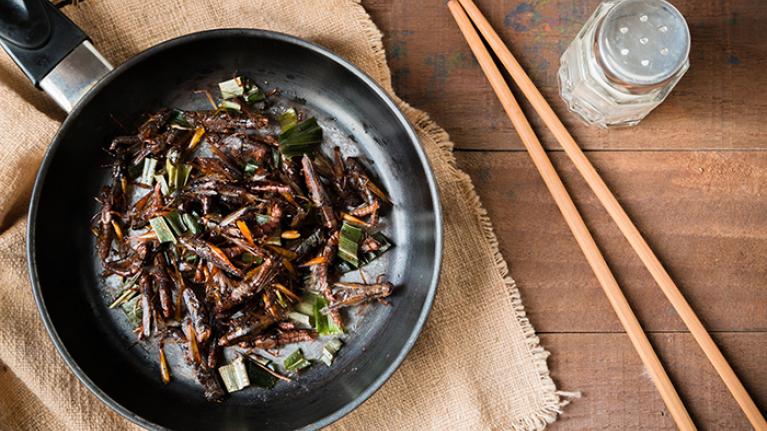
To eat, or not to eat: this is the question!
Article
November 2018
People throughout the world have been eating insects (entomophagy) on a regular basis for millions of year. In our days around 2 billion people regularly consume edible insects, however eating insects in Western Europe is still a taboo. The consumer attitudes meant that farming of insects with few exception (bees) is rather absent, until in recent years due to their potential contribution towards ensuring global feed and food security. FAO (Van Huis et al. 2013) and the EU support research on the use of insects for food and feed as insects have higher conversion efficiency to proteins, requiring up to 10 times less feed than to cattle, produce fewer greenhouse gas and ammonia and use less water. Most species are high in protein above 70% of dry matter and contain all the essential amino acids. The fatty acid profile reveals better ratios of saturated/unsaturated fatty acids than poultry or fish, containing higher amounts of polyunsaturated fatty acids (Schlup & Brunner, 2018).
There are many studies that look at consumer acceptability of insect products for the emotional and sensory profiling. Observations relate that when customers are blinded, they prefer meat rather than veggie or insect burgers, however the overall likeness of insect burgers was comparable to likeness of veggie burgers (Schouteten et al. 2016). The informed evaluation results reflected the blind evaluation for the insect burgers. The expected (emotional profile) liking for the products is usually lower for veggie burgers and insect burgers. The predicted likelihood of adopting insects as food source is 12.8% for males and 6.3% for females. People who are familiar with the idea of eating insects are 2.6 times higher possibility to adopt them in diet, whereas people who intend to reduce meat consumption are 4.5times higher chances to adopt insects (Verbeke 2014). Food neophobia is the strongest contributing factor of predicting the odds of being ready to adopt entomophagy.
Chinese consumers accepted processed and unprocessed insects, whereas German consumers accepted only processed as insects were not visible (Hartmann et al. 2015). There are nine significant parameters that predict the willingness to consume insects: convenience orientation, discernibility of insects in food, expected healthiness, familiarity, food neophobia, food technology neophobia, perceived health benefits of meat, gender and prior consumption.
In order to obtain the ‘prior consumption’ element and overcome the food neophobia, you could try one of the products by Eat Grub, a company that developed one of their products with the WLFIL, and make the decision for yourself! Insects are consumed for their taste, mopane caterpillars in South Africa or weaver ant eggs in Southern Asia can fetch very high prices!
Dr Amalia Tsiami, Academic Support, Amalia.Tsiami@uwl.ac.uk
References
Hartmann, C., Shi, J., Giusto, A. and Siegrist, M., 2015. The psychology of eating insects: A cross-cultural comparison between Germany and China. Food quality and preference, 44, pp.148-156.
Schlup, Y. and Brunner, T., 2018. Prospects for insects as food in Switzerland: A tobit regression. Food Quality and Preference, 64, pp.37-46.
Schouteten, J.J., De Steur, H., De Pelsmaeker, S., Lagast, S., Juvinal, J.G., De Bourdeaudhuij, I., Verbeke, W. and Gellynck, X., 2016. Emotional and sensory profiling of insect-, plant-and meat-based burgers under blind, expected and informed conditions. Food quality and preference, 52, pp.27-31.
Van Huis, A., Van Itterbeeck, J., Klunder, H., Mertens, E., Halloran, A., Muir, G. and Vantomme, P., 2013. Edible insects: future prospects for food and feed security (No. 171). Food and Agriculture Organization of the United Nations.
Verbeke, W., 2015. Profiling consumers who are ready to adopt insects as a meat substitute in a Western society. Food Quality and Preference, 39, pp.147-155.

